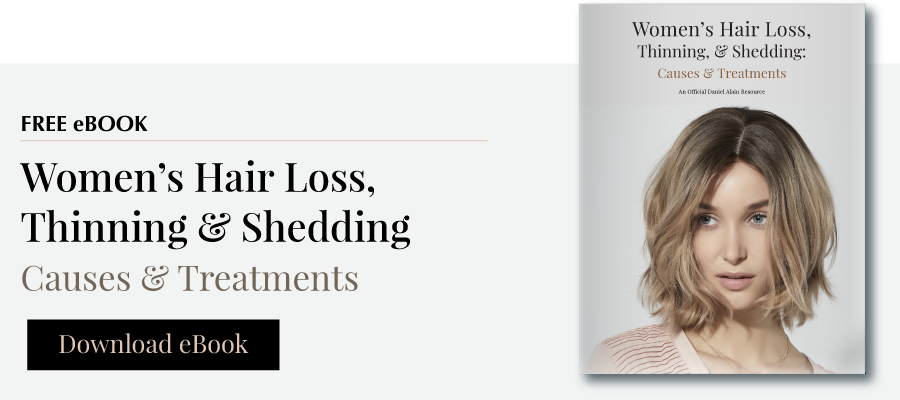Is There a Remedy for Women's Thinning Hair?
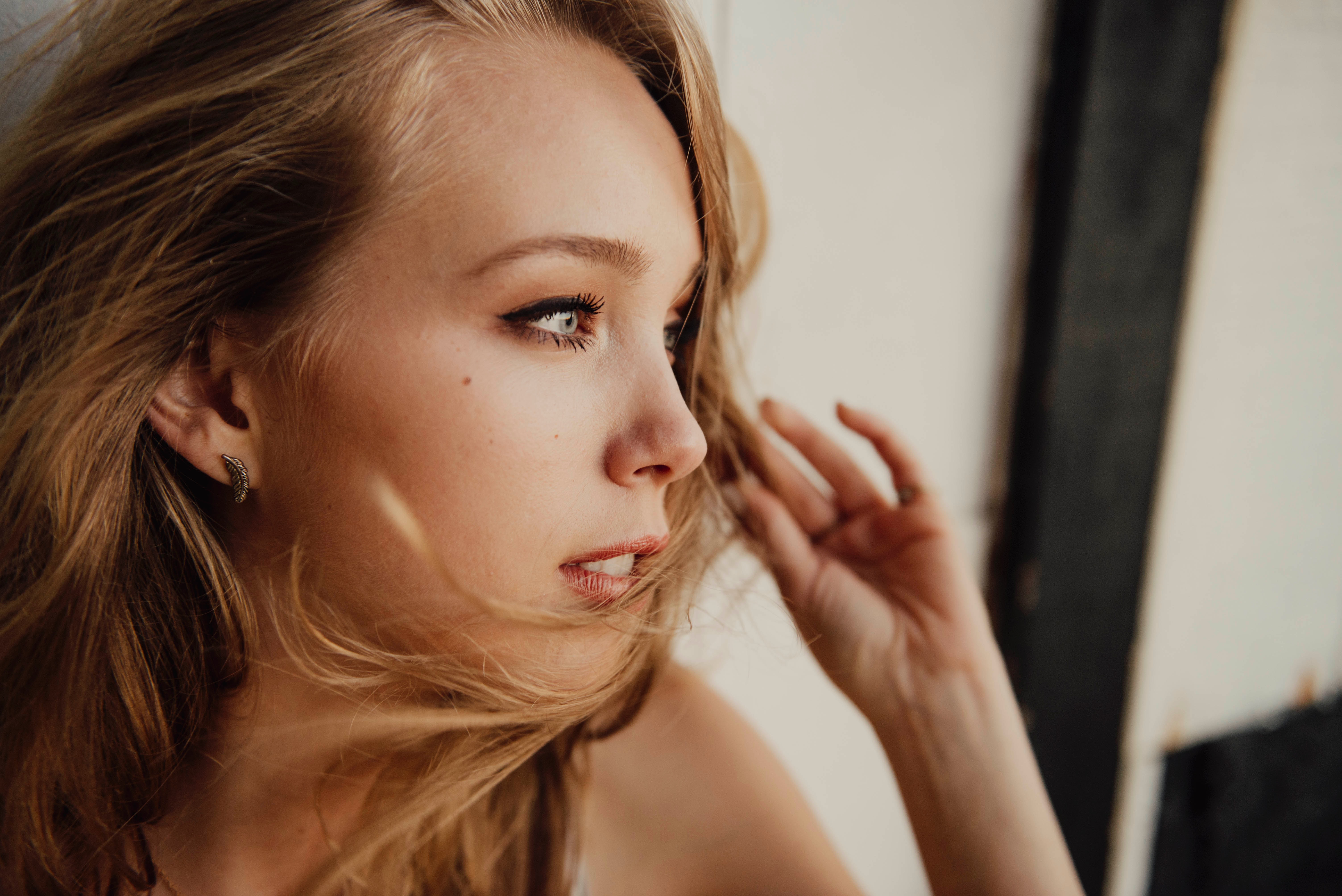
You’re getting ready for work one morning. Time to shower, style your hair, and suit up. Only each day that goes by, it’s harder to ignore the anxiety you feel when you look in the mirror. Thinning hair in women has that effect — a lighter ponytail, slumpy wave, uncomfortably exposed hair part — what happened to the pompadour look you achieved with one blow-dry? Or the voluminous ponytail after one tease?
You’re not alone. Here at Daniel Alain, we’ve seen thousands of women endure the same symptoms. Thinning hair might not look like hair loss right away, but it’s no less disheartening. But here’s the thing: women’s hair thinning doesn’t have to steal your shine.
We’re going to give you the 411 on hair thinning in women — causes, symptoms, and of course, solutions.
What Causes Thinning Hair in Women?
So many factors play a role in female hair thinning that it’s tricky to pinpoint the main culprit. That’s why we’ve put together an extensive list of potential causes, to help you narrow it down. Once you find out the cause? You might find that missing piece in your hair loss journey.
Over Treating Your Hair
Does your hairstylist ever promote a hair treatment to hydrate or repair your damaged hair? Hair professionals have access to many treatments and recommendations for you to treat your hair at home. Maybe you’ve tried one of the following:
- Hot oil treatment
- Hair relaxing treatment
- Deep conditioning treatment
- Clarifying treatment
Let’s look at hair relaxing treatments. They’re meant to make your hair more manageable, less curly, and more “relaxed.” Common hair relaxers include sodium hydroxide, calcium hydroxide, and ammonium thioglycolate. But maybe you’ve used hair relaxers too often, or one treatment was overtreating your particular hair. One trichology study examined the effects of hair relaxing treatments on 90 women. The results?
- 95.56% reported adverse effects, in which:
- 61% reported dandruff
- 67% reported frizzy hair
- 47% reported female hair thinning, specifically over the scalp’s center
Our advice? Contact your dermatologist or medical professional before using any hair relaxing treatments.
Another popular hair treatment is clarifying, also known as deep cleaning shampoo or treatment. They’re used to remove any product buildup in your hair. That styling mousse or thickening gel might remain even after you regularly shampoo.
A clarifying shampoo effectively removes the polymer film that builds up and weights on your hair shafts. Experts recommend using clarifying treatments every two weeks. Over-treating your hair with clarifying shampoo and treatments might cause:
- Seborrheic dermatitis (scalp rash and irritation)
- Scalp dryness
- Psoriasis
Hot oil treatments are designed to repair and moisturize hair, but the heat can actually cause more damage.
Bottom line? Exercise caution with hair treatments. If you plan to treat hair thinning with treatments, consult a dermatologist first.
Using Harsh Hair Products
Like hair treatments, hair products can also contain harmful chemicals that exacerbate thinning hair in women. Try to avoid products that have:
- Sulfates
- Formaldehyde
- DMDM hydantoin
- Synthetic fragrances
- Alcohol
- Parabens
Hairstyles
Are you a sucker for slicked-back buns or sky-high ponytails?
Unfortunately, tight hairstyles, including buns, ponytails, cornrows, up-dos, and braids can cause traction alopecia, a type of hair loss that occurs with pulling on the hair follicles. You might notice a receding hairline, widening hair part (both hair thinning symptoms), and headaches.
But don’t worry — you don’t have to say goodbye to your glamorous Kim-K bun forever. Just opt for looser hairstyles for traction alopecia every so often.
Vitamin Deficiency
Your hair might be lifeless, but your follicles aren’t! They need nutrients and oxygen to thrive (and survive). If your hair starts thinning, look at your diet and supplement list.
Hair thinning might begin with a shortage of these nutrients:
- Biotin
- Omega fatty acids
- Protein
- Iron
- Calcium
- Vitamin B12, C, E & D
So, how can you tell if you have any nutritional deficiencies? Load up on the best foods for hair growth. Record your food intake for a short while, or see a doctor. They might advise a blood test to see if you have healthy vitamin levels.
Autoimmune Diseases, System Deficiencies, and Medical Conditions
Immune deficiency disorders reduce your immune system’s ability to respond to infection. Meaning? You get sick faster and take longer to recover. Autoimmune diseases are characterized by your immune system attacking your body.
But it’s not only your main bodily functions that need more time to recover from infections. Your hair follicles are also affected. For example, Crohn’s Disease and Graves’ Disease both have hair thinning and loss as a side effect. Alopecia areata is an autoimmune disease in which your body attacks your hair follicles.
Hormonal Changes
How often has your doctor blamed your latest ailment on hormones? Feeling moody? Hormones. Gaining weight? Hormones. Thinning hair? Hormones.
These bodily chemical messengers are temperamental, but certain hormonal imbalances in particular wreak havoc on your hair: cortisol (stress hormone), testosterone, thyroid hormones, estrogen, and progesterone.
Luckily, healthier lifestyle changes might be enough to combat the hormonal rage on your follicles. If not, talk to your doctor about Minoxidil or hormone replacement therapy.
Genes
Did you know that genes are the most significant cause of shedding and thinning hair in women? Androgenetic alopecia, also known as hereditary hair loss, causes a widening hair part and thinning across the scalp, and can occur as early as puberty.
Stress
Stress has psychological and physical repercussions. Anxiety, depression, and irritability might indicate stress, but so might hair thinning.
Unfortunately, the list of things that stress us out doesn’t seem to end. Relationships, work, societal pressures, mental health issues, finances — any of these life aspects could stress you out enough to thin your hair and cause telogen effluvium.
Remember that pesky hormone, cortisol? Stress triggers it, and it’s disruptive enough to force your hair follicles from the anagen (growth) phase into the shedding (exogen phase).
Aging
Aging causes your hair to become more thin AND fine. You’ll lose more hair, decreasing the density and revealing more patches and space between your hair strands. That covers thinning. But your hair will become finer as well because your individual hair strands decrease in diameter. The two together exacerbate the prominent look of female hair thinning.
On top of that, aging makes you more prone to other underlying health conditions that could have hair loss as a symptom.
The good news is that hair thinning in women getting older is normal. It’s part of life, but that doesn’t mean it has to have power over your mood and self-image! You can combat hair thinning from aging with wigs and toppers, hair fall treatments, and improved nutrition.
And by nutrition, we definitely don’t mean scary diets and excessive calorie restriction.
Crash Dieting/Sudden Weight Loss
Remember how stress can cause telogen effluvium? Certain nutritional habits and changes act as physical stressors to your body. Your hair can react with the same symptoms of stress-induced hair loss – shedding, thinning, and stunted hair growth.
If you want to lose weight, the internet has no shortage of extreme diets to try. The vegetable soup diet, master cleanse, and baby food diet are some examples of shock diets that cause your body to lose weight — and hair, in some cases.
One study of female hair loss causes found that 6% of participants experienced hair loss and thinning after crash dieting.
That same study found that 7% of cases were caused by childbirth.
Childbirth
If you’ve been pregnant, you know about the pregnancy glow. Your skin clears up and your hair feels more radiant than ever. And we all know how incredible a good hair day feels — imagine a whole few months of great hair days!
Then you finally give birth and wham. Estrogen levels fall, and your hair starts shedding and thinning. Childbirth hair thinning is a wave that eventually subsides within a year. In the meantime, the American Association of Dermatology recommends you mitigate with volumizing shampoos and fine-hair conditioners.
Menopause
Menopause is an unrelenting wave of mood swings, hot flashes, and other uncomfortable symptoms. But it’s a natural part of womanhood. The only thing we didn’t expect was the hair thinning that came with it.
Why is menopause harping on your hair follicles?
First, you have rapidly falling estrogen and progesterone levels. Then, extra androgens lead to follicular miniaturization, which is exactly what it sounds like — a fancy word for hair thinning.
Your hair texture thins out (miniaturize), and your hair sheds faster than normal. But like every woman’s life stages, this too shall pass. You can also mitigate menopausal hair loss with a healthier lifestyle or medication like Minoxidil or Finasteride.
Medications
Even the most unassuming medications could have hair thinning and loss as a side effect. Have you taken penicillin recently for pneumonia or a bacterial throat infection? Antibiotics, even if used temporarily, could contribute to your hair thinning.
Steroids, thyroid medications, antidepressants, and mood stabilizers could also be potential culprits. Our advice? Check the prescription label for side effects and talk to your doctor if you notice any thinning. Medication could be a factor, but it’s not the most likely cause of hair thinning. Medications with hair loss side effects only manifest in 1-10% of patients.
Medical Conditions
Many medical conditions contribute to hair thinning include:
- Autoimmune polyendocrinopathy-candidiasis-ectodermal dystrophy (APCED)
- Diabetes
- Heart disease
- High cholesterol
- Anemia
- Thyroid conditions — often occurring when your thyroid produces too little or too many hormones.
If you suspect your hair loss is caused by an underlying medical condition, consult your doctor and dermatologist about your options.
Cancer Treatment
Radiation therapy and chemotherapy are known to cause hair loss and thinning in both men and women. Since an environmental shock causes this type of hair loss, it’s known as anagen effluvium. Hair thinning usually subsides after you complete treatment. You might consider some of Daniel Alain’s best wigs for cancer patients in the interim.
Lack of Sleep
Often, the underlying cause of sleep disorders is stress. Insomnia is just one route toward stress. When you don’t get enough sleep, your body reacts by reducing the stress hormone, cortisol. Improving sleep hygiene is one of many ways to manage stress and, in turn, hair thinning.
Symptoms of Thinning Hair in Women
Hair thinning in women is usually detected when you notice one or more of the following symptoms.
Wider Center Parting
The diameter of your hair part widens if your hair starts thinning. This means more of your scalp will show in your everyday hairstyles. You might consider switching your hair part to a side that shows less thinning as a temporary measure.
Receding Hairline
Most hairlines begin to look crooked at the onset of recession — eventually, they adopt an M shape, with your hairline receding more at the sides. A normal hairline for women should be between 2-2.4 inches above your eyebrows, but minor widow peaks are common.
Decreased Density
Decreased density is the definition of hair thinning and women. You shed some hair, regrowth slows down, and more space appears between your hair strands.
Scanty Hair
Scanty hair is also known as fine hair, often with a hair strand diameter under 0.05 mm.
Decreased Volume
Women with hair thinning might struggle to achieve body and volume in their hairstyles. Instead of a thickened poof, your ponytail might feel heavy and deflated. That’s because there’s less hair to pump up the volume if your hair is thinning.
Loss of Hair Growth on the Scalp
Patchy spots along the temples, crown, hairline, and hair part all indicate hair thinning.
Itchy, Flaky Scalp
Dandruff isn’t only a symptom of hair thinning in women — it’s also a cause! A dry scalp causes a domino effect of itching, scratching, damage, and hair thinning.
Slow or Lack of Hair Growth
You may notice your hair stops growing at a certain length, and hair ends may look split and dry. Even after a fresh cut, new hairs struggle to grow in.
What to Do About Thinning Hair in Women
Patches, widening parts, and a loss of volume aren’t the final chapter in your hair loss journey. If you want to know what to do for female hair thinning, keep reading!
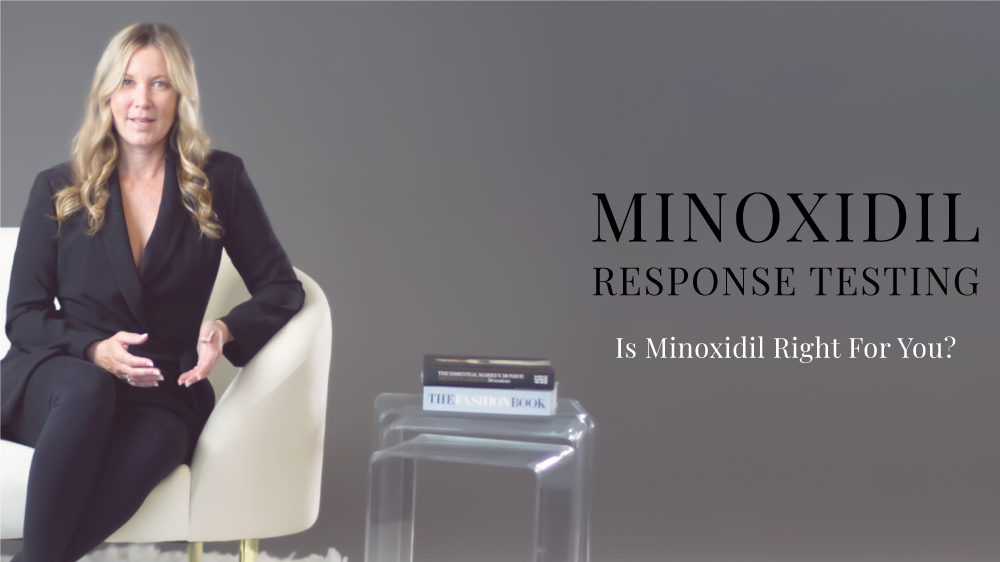
Find Out if Minoxidil Will Work to Thicken Your Hair
Minoxidil is an FDA drug that increases hair density and promotes hair regrowth in responders with hereditary hair
loss, which causes hair thinning in women.
You can purchase the solution in a liquid or foam version and apply it topically on your scalp. The result? Ideally, hair regrowth within three months, though it can take as long as 9-12 months for some responders.
Speaking of responders, what do you need to activate Minoxidil? For years, medical experts had no clue — until Daniel Alain conducted breakthrough research to discover the novel SULT1A1 enzyme activity common in all responders.
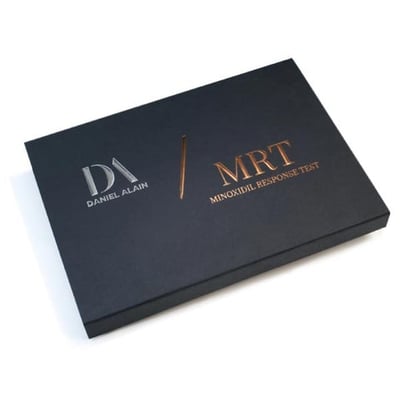
Now, we offer the only product on the market that lets you immediately determine if Minoxidil will work for you: the Minoxidil Response Test (MRT).
But even if you’re a responder, Minoxidil’s side effects aren’t all roses. Some women report hair growth in uncomfortable places like their faces and backs. Others noticed feelings of anxiety, distress, and even dizziness.
Fortunately, there are other options to tackle hair thinning.
Use an Anti-Hair Shedding Treatment to Retain Your Hair.
Hair thinning in women results in shedding that widens the space between existing hair strands. Early in your hair loss journey, you might focus on retaining your hair.

Daniel Alain’s hair shedding treatment, INTACT, is clinically proven to reduce hair shed in as little as 30 minutes.How? We crafted the product’s PiliLock® Sevilla Orange Complex to firmly grip your hair strands at the root and keep them in place even during showers, styling, and brushing.
But if you're craving more coverage, a topper might be a better solution.
Consider Wearing a Wig or Topper
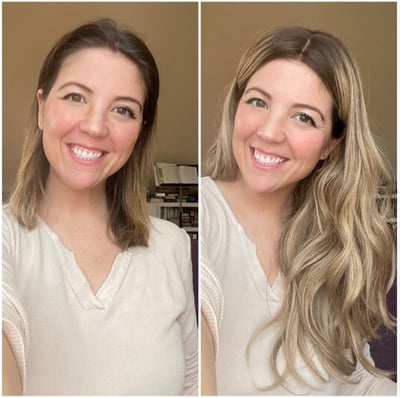 Placed at the crown of your head, the best hair toppers offer an undetectable volume boost. Daniel Alain offers 100% European human hair toppers in varying lengths and colors to fit your style.
Placed at the crown of your head, the best hair toppers offer an undetectable volume boost. Daniel Alain offers 100% European human hair toppers in varying lengths and colors to fit your style.
Check out our Chic topper — imagine the volume oomph it’ll add to spruce up your hair and give you a confidence boost, too!
But if you’re craving even more coverage, or have more extensive hair loss, a human hair wig offers the most concealment and security.
Daniel Alain has the largest, private reserve of 100% European human hair in the world. That’s why our wigs are second to none when it comes to quality, lifespan, and undetectability. Download our Ultimate Wig Buying Guide to learn everything you need to know about choosing a right wig.
Find a Solution for Hair Thinning at Daniel Alain
Hair thinning in women might creep up and deplete your confidence, be it from childbirth, menopause, or genetics. But once you learn what’s causing your hair to thin, you’ll regain your power and come closer to a solution.
Solutions aren’t uniform for everyone — that’s why Daniel Alain offers so many ways to add volume and boost your thinning hair. From hair fall treatments to 100% human hair wigs, our women’s hair loss solutions will help you reclaim power over your hair, and your confidence.
You deserve to shine and sparkle when you tackle any hobby, social event, or work meeting — let us help you reawaken your femininity.
book a free consultation
Our stylists will help you find the right hair loss solution
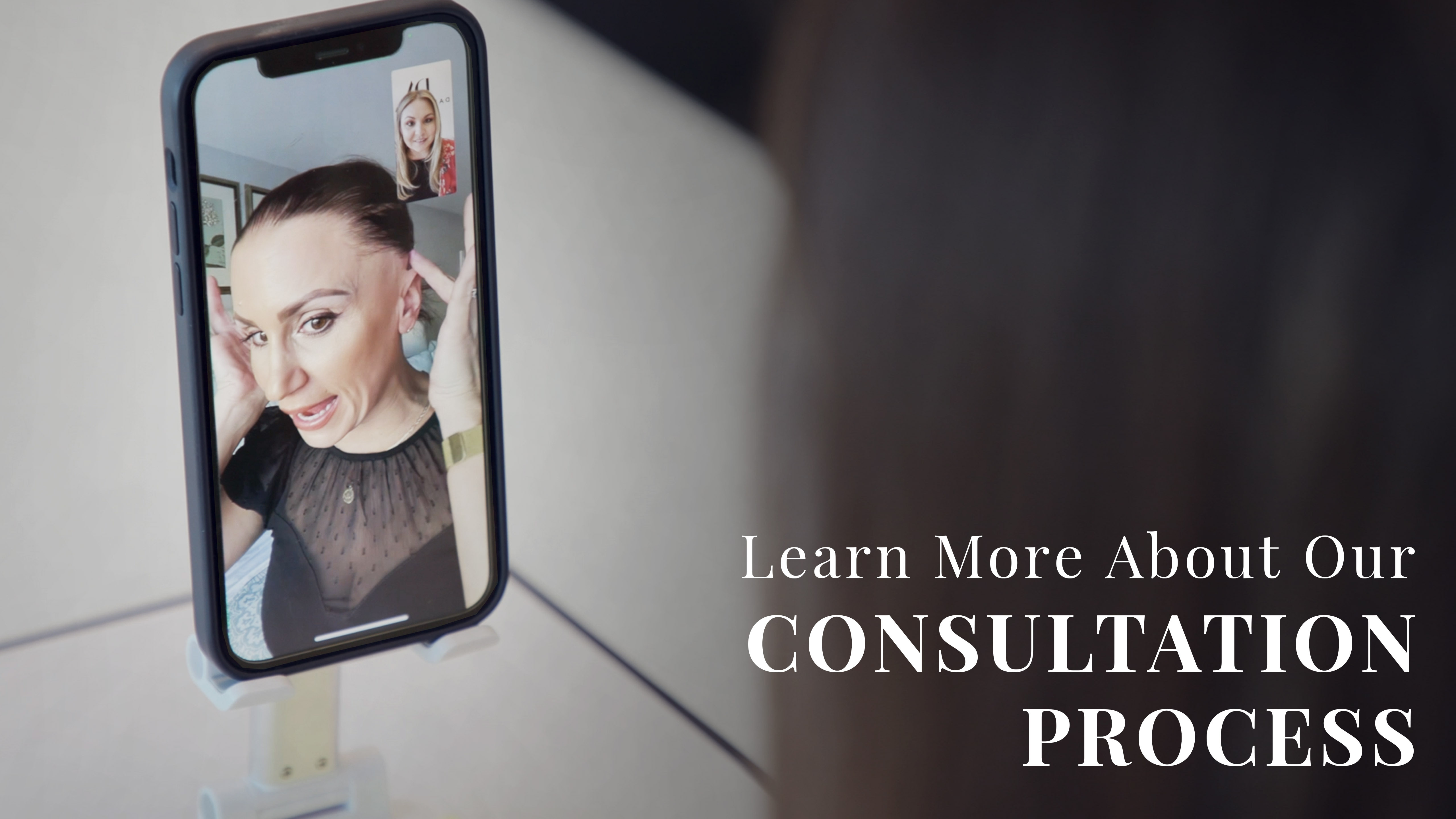
Frequently Asked Questions
Can Hair Grow Back After Thinning?
Yes, in many cases, your hair can grow back after thinning. Thinning in women caused by childbirth, stress, nutritional deficiencies, hormones, and hairstyles could subside with:
- Improved nutrition
- More relaxed lifestyle
- Time
- Medication like Minoxidil
- Exercise
However, some cases might cause permanent damage that may warrant a cosmetic solution like a wig or hair topper.
Can Female Hair Thinning Be Reversed?
Yes, you can reverse some cases of female hair thinning by finding the root cause and tackling it head-on with treatment approved by a dermatologist or doctor.
What is the Best Treatment for Thinning Hair in Women?
The best treatment differs for everyone. If your diet is causing hair thinning, vitamin supplements or ceasing a crazy diet is your best treatment. If hair thinning is genetic, a hair fall treatment, medication, or wig might be your best solution.
What are the Different Stages of Thinning Hair?
The Norwood Scale helps medical professionals assess the stages of thinning hair and hair loss.
- Stage 1: No signs of thinning
- Stage 2: Slow receding of the hairline
- Stage 3: More significant recession at the temples
- Stage 4: More hair loss at the vertex (top of the scalp)
- Stage 5: Hair becomes more sparse and balding at the vertex
- Stage 6: Widening hair part
- Stage 7: Hair loss areas at the temples merge with the top of scalp
- Stage 8: Hair loss all across the top of the scalp
How Can I Thicken My Thinning Hair?
The best way to thicken thinning hair is to find the root cause. Only then can you tailor a solution to directly address your thinning. That solution might entail nutrition changes, looser hairstyles, medication, wigs, etc.
Why is My Hair Suddenly Thinning?
Many factors could contribute to sudden hair thinning, like stress, childbirth, medical conditions, hormones, or genetics.
Can a Vitamin D Deficiency Cause Hair Thinning?
Yes! A vitamin D deficiency can cause hair thinning and loss, specifically telogen effluvium and androgenetic alopecia. However, studies are limited, so you should always consult your doctor before taking a new supplement.
Does Biotin Thicken Hair?
Biotin is a B vitamin that helps you process food into energy. While biotin deficiency is commonly associated with hair loss, research is limited in proving biotin supplements as a solution to thinning hair in women.
What are the Best Products for Female Hair Thinning?
One incredible product for hair thinning is Daniel Alain’s INTACT hair fall treatment. It helps you retain your existing hair and prevent shedding. For specific product recommendations, consult your dermatologist or doctor.
What are the Best Natural Remedies for Thinning Hair in Women?
Some natural remedies for thinning hair include:
- Stress management like yoga and meditation
- Vitamin supplements like biotin, iron, Vitamin C, and Vitamin D
- Exercise to improve circulation
- Looser hairstyles
- Scalp massage
What is the Best Hairstyle for Thin Hair?
You can mitigate the look of thin hair with many different hairstyles, such as:
- Wispy bangs
- Layers
- Shags and fringes
Additionally, looser hairstyles like letting your hair down and loose ponytails can reduce hair thinning and loss from traction alopecia.
What is the Best Shampoo for Female Thinning Hair?
The absolute best shampoo for your hair thinning is one recommended by your dermatologist or doctor.
For example, dermatologists prescribe shampoo with clobetasol propionate for hair thinning caused by scalp psoriasis. Additionally, dermatologists recommend using shampoos specific to your hair type, such as shampoos meant for color-treated hair.
You might consider a thickening shampoo for temporary relief, though it won’t solve hair loss.
When Should I See a Doctor About Hair Thinning?
You should see a doctor as soon as you notice hair thinning — not as an emergency, but as an opportunity to learn more about your body and hear sound medical advice. Some symptoms to look out for include:
- Hair clumps in the shower or your hairbrush
- Widening hair part
- Receding hairline
- Lighter ponytails
- Pathy spots on your scalp


